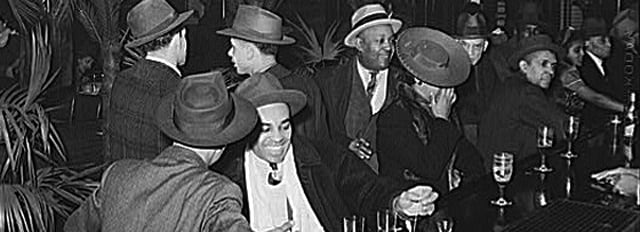
Remembering 47th Street
Ella Fitzgerald played there often. So did Lena Horne, Duke Ellington,
Josephine Baker, Louis Armstrong and countless others. They played in legendary
clubs like Chez Paree, the Parkway Ballroom, Gerri's Palm Tavern, and the
Regal Theatre located on or around 47th Street, during the heyday of Chicago's
Bronzeville community on the South Side. By day, 47th Street was a vibrant
commercial district; at sundown it was transformed into a throbbing center
of nightlife.
By 1920, more than 50,000 rural Southern blacks had migrated to Chicago
to escape the cotton fields and the threat of lynchings, but they soon
found that segregation left people without some simple comforts, such as
places to shop and eat. Gerri Oliver, owner of The Palm Tavern, remembers, "You
couldn't try on shoes downtown. You couldn't try on hats and coats downtown." Dempsey
Travis concurs: "There was a five and ten cent store at Washington and
State where they'd give you a glass of Coca-Cola with a red bottom, to
make sure no white folks would ever drink after a Negro." Thus, out of
necessity, 47th Street, or Bronzeville, began to prosper, and became a
source of pride and a haven for Chicago's blacks. After all, "[there was
no point in] going down to Henry C. Litton's to be insulted when you could
buy the same Hart, Shaffner & Marx suit from 47th Street," recalls historian
Timuel Black. Ironically, the majority of Bronzeville's businesses were
managed by blacks, but owned by whites.
Among the many exclusive shops, upscale restaurants and other businesses
flourishing in the community was a large department store, South Center,
which catered almost exclusively to blacks. One entire floor became the
training ground for Madame C. J. Walker, whose school became a fixture
in the community, helping many men and women become independent business
owners. No longer were educated blacks limited to jobs at the post office
-- doctors and lawyers could set up their practices on 47th Street. The
first twelve black certified public accountants in America had their offices
in South Center. A small but vibrant black leisure class was emerging,
and 47th Street offered black Chicagoans a sense of freedom they couldn't
find anywhere else in America at that time.
By the mid-1950s, the civil rights movement and racial integration were
bringing a new lifestyle to blacks. And life along 47th Street would change,
too. Gerri Oliver recalls, "The neighborhood declined because the people
started moving out once they were allowed to." Once the residents began
to migrate, many upscale businesses followed suit. Tastes in music and
entertainment changed, and high-rise public housing began to replace the
community's most beloved institutions. The Regal was demolished. The Savoy
became a welfare office. The street that had once been the center of the
universe for black Chicago became a blighted area.
But the face of 47th Street may be changing again. Its proximity to downtown
has led to a rush of real estate development. There's a cultural center
going up on the site of the old Regal Theater and several upscale housing
units are planned. But how much will redevelopment compromise the integrity
of the street's rich heritage? Will the character of the neighborhood be
preserved or reduced to a museum-like imitation of its former glory? For
the once proud 47th Street, many questions remain.
Chicago Stories: Remembering 47th Street was written and produced by Rita
Coburn Whack, and narrated by television personality (and Bronzeville native)
Merri Dee, with an original musical score composed and performed by internationally-known
jazz trumpeter Malachi Thompson and his Africa Brass.
Links of Interest
Bronzeville
Conversation: 47th Street and South Park Boulevard – Bronzeville's
Downtown
Bronzeville
Cultural Traditions
Short
History of the Mayor of Bronzeville
Gerri's Palm Tavern is one of the stops in...
National
Geographic: Traveling the Blues Highway

Your $40 Gift Membership will include:
|
























































